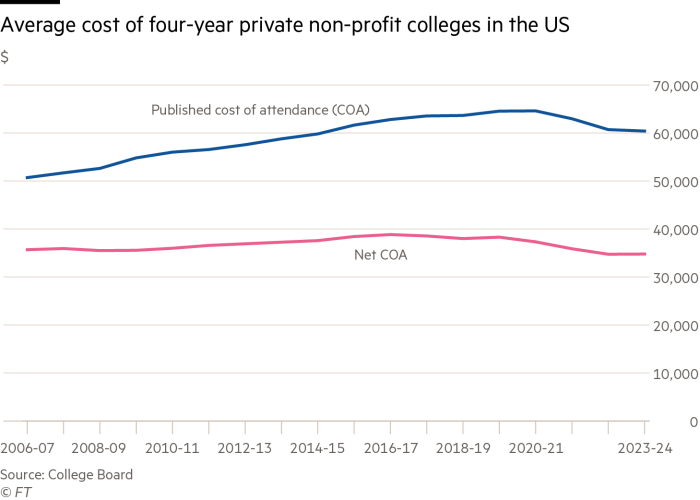Unlock the Editor’s Digest for free
Roula Khalaf, Editor of the FT, selects her favourite stories in this weekly newsletter.
The sky-high cost of a college education in the US is back in the spotlight. Vanderbilt University made headlines this month after a letter sent to a newly admitted engineering student showed the total cost of attendance would be $98,426 for the 2024-25 school year.
The near six-figure price tag set off a fresh round of debate over the value and affordability of higher education in the US. The total cost of attending a four-year university course has almost tripled between 1980 and 2020, according to data from the National Center for Education Statistics (NCES). That is adjusted for inflation. Schools including Wellesley, the University of Southern California, Boston University and the University of Pennsylvania all boast costs of more than $90,000 for the coming academic year. That compares with the median US household income of $74,580,
Yet the focus on the sticker price may not be the best way to understand the affordability crisis. For starters, prices differ greatly between private and public colleges. New York state residents pay about $7,000 a year in tuition to attend an in-state public university compared with more than $67,000 a year for Columbia University.
Second, the headline price is a total cost figure. It includes tuition, room and board, fees, books, transport and other expenses. Only a small percentage of students actually pay this amount. Thanks to financial aid, which can include merit scholarships, grants and work-study programmes, most students pay much less.

Once financial aid is factored in, data from the College Board shows that the net price paid by students at both public and private non-profit four-year institutions is actually lower for the 2023-24 academic year than in 2006-7. At Vanderbilt, students whose families have an income of $150,000 or less pay no tuition in most instances.
Net price is by no means a perfect metric. The net price that many lower- and middle-income students must pay is still too high at many colleges — especially when compared to some countries in Europe, where university is free or nearly free for everyone.
Still, it is a better gauge of how much a college education would actually cost a prospective student. Finding better ways to report and track net prices would be one step towards tackling the problem of affordability. Demanding greater transparency on how colleges calculate their financial aid is another. To tackle the student debt crisis, schools should also be banned from classifying federal student loans as a form of financial aid.
A college education may not be the right path for everyone. But the decision to go should be based on accurate pricing information.











